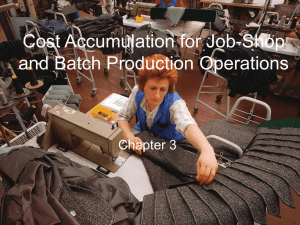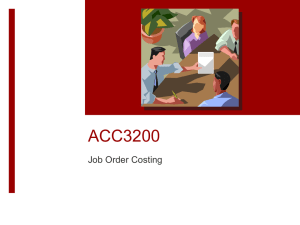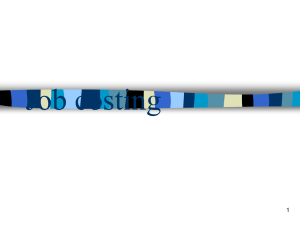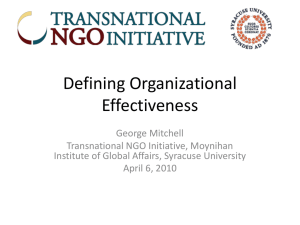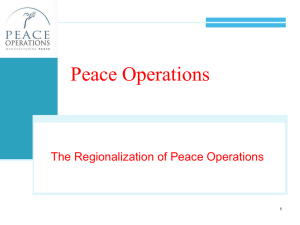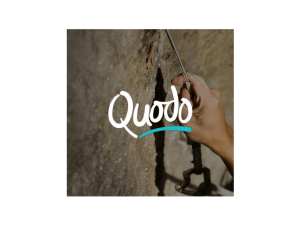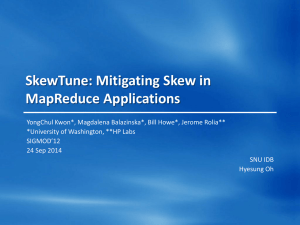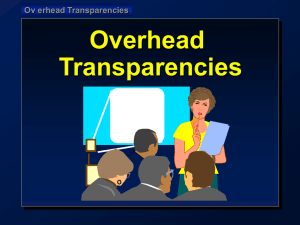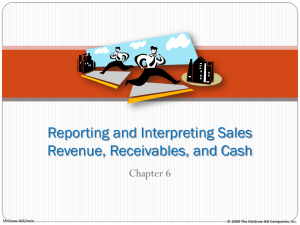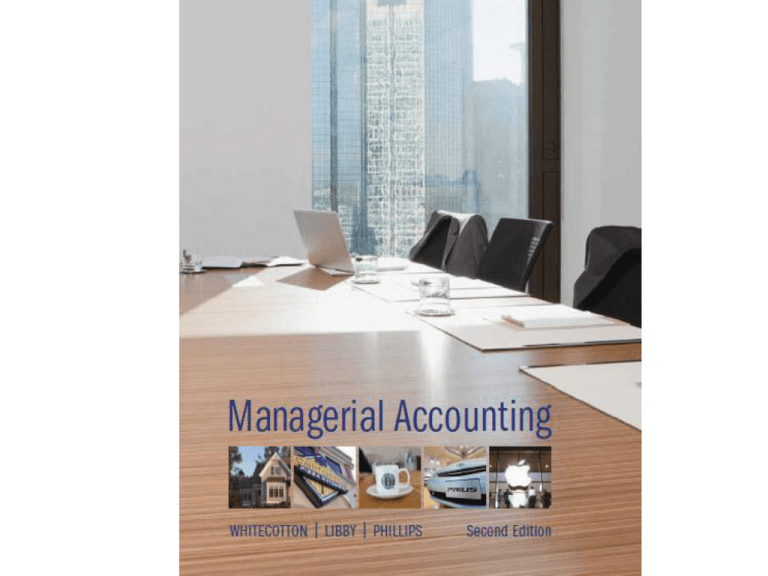
Chapter 2
Job Order Costing
PowerPoint Authors:
Susan Coomer Galbreath, Ph.D., CPA
Charles W. Caldwell, D.B.A., CMA
Jon A. Booker, Ph.D., CPA, CIA
Cynthia J. Rooney, Ph.D., CPA
McGraw-Hill/Irwin
Copyright © 2014 by The McGraw-Hill Companies, Inc. All rights reserved.
Learning Objective 2-1
Describe the key differences between
job order costing and process
costing.
2- 3
Job Order versus Process Costing
2- 4
Process Costing
Average
Unit
Cost
=
Total Manufacturing Cost
Total Units Produced
Costs are traced to the process and then divided
by units produced to obtain an average unit cost.
2- 5
Manufacturing Cost Categories
Direct
Labor
Direct
Materials
Manufacturing
Overhead
2- 6
Assigning Manufacturing Costs to Jobs
2- 7
Learning Objective 2-2
Describe the source documents
used to track direct material and
direct labor costs to the job cost
sheet.
2- 8
Materials Requisition Form
2- 9
Direct Labor Time Tickets
$700 charged to Job 2719
$300 charged to Job 3335
2- 10
Learning Objective 2-3
Calculate a predetermined
overhead rate and use it to apply
manufacturing overhead cost to
jobs.
2- 11
Job Cost Sheet
?
Manufacturing overhead is assigned to specific jobs
using a predetermined overhead rate, our next topic.
2- 12
Predetermined Overhead Rates
Manufacturing overhead is applied to jobs that are in
process. An allocation base, such as direct labor
hours, direct labor dollars, or machine hours, is used
to assign manufacturing overhead to individual jobs.
We use an allocation base to apply manufacturing overhead because:
1. It is impossible or difficult to trace overhead costs to particular
jobs.
2. Manufacturing overhead consists of many different items ranging
from the grease used in machines to a production manager’s
salary.
3. Actual overhead for the period may not be known until the end of
the period.
2- 13
Predetermined Overhead Rates
The predetermined overhead rate (POHR) used to
apply overhead to jobs is determined before the
period begins using estimates.
Predetermined
Overhead
Rate
=
Estimated Total
Manufacturing Overhead Cost
Estimated Total Cost Driver
Ideally, the allocation base is a cost
driver that causes overhead.
2- 14
Predetermined Overhead Rates
Because home building is a labor intensive business, Toll
Brothers uses direct labor hours as the overhead allocation
base. Toll Brothers estimates the total manufacturing
overhead cost for the year to be $750,000, while direct labor
hours are estimated to be 10,000. What is Toll Brothers
predetermined overhead rate?
$750,000
POHR =
10,000 direct labor hours (DLH)
POHR = $75.00 per DLH
For each direct labor hour worked on a job, $75.00 of
manufacturing overhead will be applied to the job.
2- 15
Predetermined Overhead Rates
Based on estimates, and
determined before the
period begins.
Predetermined
Overhead
Rate
×
Actual
Cost
Driver
=
Applied
Manufacturing
Overhead
Actual amount of the cost driver such as units
produced, direct labor hours, or machine hours
incurred during the period.
2- 16
Predetermined Overhead Rates
Predetermined
Overhead
Rate
$75
×
Actual Direct
Labor Hours for
Job 2719
300 DLH
=
Overhead
Applied
to Job 2719
$22,500
2- 17
Predetermined Overhead Rates
12
2- 18
Learning Objective 2-4
Describe how costs flow
through the accounting system
in job order costing.
2- 19
Flow of Manufacturing Costs in
Job Order Costing
2- 20
Record the Purchase and Issue of Materials
Toll Brothers purchased $150,000 in raw materials on account. Toll
Brothers withdraws $150,000 worth of materials from inventory,
$100,000 for Job 2719 (Simpson home), $40,000 for Job 3335
(Flintstone Home), and $10,000 for supplies.
Raw Materials Inventory
Purchases 150,000
Issued to production 150,000
Direct
Materials
Manufacturing Overhead
10,000
Indirect
Materials
Work in Process Inventory
140,000
Job 2719
Direct Materials
$100,000
Job 3335
Direct Materials
$40,000
2- 21
Record Labor Costs
Toll Brothers incurs $55,000 in labor costs, $30,000 for Job
2719 (Simpson home), $20,000 for Job 3335 (Flintstone
Home), and $5,000 for indirect labor.
Labor Costs
Indirect
Labor
Manufacturing Overhead
5,000
Direct
Labor
Work in Process Inventory
50,000
Job 2719
Direct Labor
$30,000
Job 3335
Direct Labor
$20,000
2- 22
Record Applied Manufacturing Overhead
2- 23
Transfer Costs to Finished Goods Inventory
and Cost of Goods Sold
Summary section
of job cost sheet
for Job 2719 after
all costs are
updated.
Direct material
Direct labor
Applied MOH
Balance
Work in Process Inventory
140,000 Job 2719 completed
50,000
60,000
75,000
175,000
Finished Goods Inventory
Cost of goods completed 175,000
2- 24
Transfer Costs to Finished Goods Inventory
and Cost of Goods Sold
Assume Job 2719, the Simpson home was sold.
Finished Goods Inventory
Cost of goods completed 175,000 When job is sold
Job 2719 sold
175,000
Cost of Goods Sold
175,000
2- 25
Record Actual Manufacturing Overhead
In addition to indirect materials and indirect labor, Toll Brothers
incurs other manufacturing overhead costs including:
•Salary paid to construction site supervisor, $12,000.
•Salary owed to a construction engineer, $8,000.
•Property taxes owed but not yet paid, $6,000.
•Expired insurance premium for construction, $4,000.
•Depreciation on construction equipment, $18,000.
Manufacturing Overhead
Actual
Applied
Indirect materials
10,000
Indirect labor
5,000
Supervisor salary
12,000
Engineer salary
8,000
Property taxes
6,000
Insurance expense 4,000
Depreciation
18,000
2- 26
Record Nonmanufacturing Costs
In addition to manufacturing costs, Toll Brothers
incurs non-manufacturing overhead costs.
1. Commissions to sales agent, $20,000.
2. Advertising expense, $5,000.
3. Depreciation on office equipment, $6,000.
4. Other selling and administrative expenses, $4,000.
These non-manufacturing costs would be recorded in
individual expense accounts, including commission expense,
advertising expense, depreciation expense, and other
expenses. The total of the selling and administrative
expense would be subtracted from gross margin on the
income statement.
2- 27
Calculate Overapplied and
Underapplied Manufacturing Overhead
Manufacturing Overhead
Actual
Applied
Indirect materials
10,000 Applied OH 60,000
Indirect labor
5,000
Supervisor salary
12,000
Engineer salary
8,000
Property taxes
6,000
Insurance expense 4,000
Depreciation
18,000
Work in Process Inventory
60,000
Job 2719
Manufacturing OH
$45,000
Job 3335
Manufacturing OH
$15,000
Actual
Applied
= MOH
MOH
The difference is closed
to cost of goods sold.
/
2- 28
Calculate Overapplied and
Underapplied Manufacturing Overhead
Manufacturing Overhead
Actual
Applied
Indirect materials
$ 10,000 Applied OH $ 60,000
Indirect labor
5,000
Supervisor salary
12,000
Engineer salary
8,000
Property taxes
6,000
Insurance expense
4,000
Depreciation
18,000
Total
63,000
60,000
Balance
$ 3,000
(Underapplied MOH)
2- 29
Learning Objective 2-5
Calculate and dispose of overapplied
or underapplied manufacturing
overhead.
2- 30
Disposing of Overapplied and
Underapplied Overhead
The most common method for disposing of the
balance in Manufacturing Overhead is to make a
direct adjustment to Cost of Goods Sold.
Overapplied
Manufacturing
Overhead
(credit balance)
Decreases
Cost of Goods
Sold
Underapplied
Manufacturing
Overhead
(debit balance)
Increases
Cost of Goods
Sold
2- 31
Disposing of Overapplied and
Underapplied Overhead
2- 32
Summary of Recorded Manufacturing
and Nonmanufacturing Costs
2- 33
Learning Objective 2-6
Calculate the cost of goods
manufactured and cost of goods
sold.
2- 34
Cost of Goods Manufactured Report
Toll Brothers
Cost of Goods Manufactured Report
Beginning raw materials inventory
$
Plus: Raw material purchases
Less: Indirect materials
Less: Ending raw materials inventory
Direct materials used
Direct labor
Manufacturing overhead applied
Total current manufacturing costs
Plus: Beginning work in process inventory
Less: Ending work in process inventory
Cost of goods manufactured
150,000
(10,000)
140,000
50,000
60,000
250,000
(75,000)
175,000
Notice that
Cost of Goods
Sold is based on
applied (not
actual)
manufacturing
overhead.
2- 35
Cost of Goods Manufactured Report
Toll Brothers
Income Statement
Sales revenue
Cost of goods sold
Beginning finished goods inventory
$
Plus: Cost of goods manufactured
175,000
Less: Ending finished goods inventory
Unadjusted cost of goods sold
175,000
Plus: Underapplied manufacturing overhead
3,000
Gross profit
Selling, general, and administrative expenses
Operating profit
$
275,000
$
178,000
97,000
35,000
62,000
From the Cost of Goods Manufactured Report
2- 36
Learning Objective 2-7
Apply job order
costing to a
service setting.
2- 37
Job Order Costing in a Service Firm
Job order costing is used in many professional service firms, including
accounting firms, law firms, advertising and public relations firms,
architectural and engineering firms, and health care providers. All of
these businesses offer specialized services to clients that tend to have
different needs or demands.
2- 38
Job Order Costing in a Service Firm
Because service firms tend to be labor intensive, the primary
driver used to assign cost is billable hours. A billable hour is the
time that can be directly attributed to a specific client and is
equivalent to direct labor hours in a manufacturing setting. In
professional service firms, each employee keeps track of how
much time is spent on each client so that the client’s account
can be charged for that cost.
2- 39
Job Order Costing in a Service Firm
Service firms incur many other indirect costs that cannot be traced to
specific clients or accounts. Examples include the non‐billable time
that employees spend on activities such as training, paperwork, and
supervision; the salaries of administrative personnel; rent and utilities
for the corporate office; and infrastructure costs such as computers,
networks, and the like. These indirect costs are treated just like
manufacturing overhead in a factory. They get assigned to individual
clients or accounts based on an allocation base, or cost driver, such as
billable hours (for an accounting firm) or the number of patient days
(for a hospital).
2- 40
Supplement Chapter 2A
Journal Entries for Job Order Costing
PowerPoint Authors:
Susan Coomer Galbreath, Ph.D., CPA
Charles W. Caldwell, D.B.A., CMA
Jon A. Booker, Ph.D., CPA, CIA
Cynthia J. Rooney, Ph.D., CPA
McGraw-Hill/Irwin
Copyright © 2014 by The McGraw-Hill Companies, Inc. All rights reserved.
Learning Objective 2-S1
Prepare journal entries to record
the flow of manufacturing and
nonmanufacturing costs in a job
order cost system.
2- 42
Recording the Purchase and Issue of
Materials
Toll Brothers purchased $150,000 of raw materials on account.
Debit
Raw Materials Inventory
Credit
150,000
Accounts Payable
150,000
The company issued $100,000 of raw materials to Job 2719 and $40,000 to
Job 3335. Indirect material of $10,000 were issued.
Debit
Work in Process Inventory
Manufacturing Overhead
Raw Materials Inventory
Credit
140,000
10,000
150,000
2- 43
Recording Labor Costs
The following labor costs were incurred during the period.
Direct labor on Job 2719 $ 30,000
Direct labor on Job 3335
20,000
Indirect labor
5,000
Total
$ 55,000
Debit
Work in Process Inventory
Manufacturing Overhead
Wages Payable
Credit
50,000
5,000
55,000
2- 44
Recording Applied Manufacturing
Overhead
Here is how we applied overhead during the period.
Direct Overhead Applied
Job #
Labor Hrs
Rate
Overhead
Simpson home
2719
600 $
75 $ 45,000
Flintstone home
3335
200
75
15,000
Total direct labor hours
800
$ 60,000
Debit
Work in Process Inventory
Manufacturing Overhead
Credit
60,000
60,000
2- 45
Transferring Costs to Finished Goods
Inventory and Cost of Goods Sold
Job 2719, the Simpson home, was completed at a cost of $175,000.
Debit
Finished Goods Inventory
Credit
175,000
Work in Process Inventory
175,000
The Simpson home was purchased for $275,000 cash.
Debit
Cash
Credit
275,000
Sales Revenue
Cost of Goods Sold
Finished Goods Inventory
275,000
175,000
175,000
2- 46
Recording Actual Manufacturing
Overhead
The following overhead costs were incurred during the period.
Debit
Manufacturing Overhead
Credit
48,000
Taxes Payable
16,000
Prepaid Insurance
14,000
Accumulated Depreciation
18,000
2- 47
Recording Nonmanufacturing Costs
Toll Brothers incurs non-manufacturing overhead costs.
1. Commissions to sales agent, $20,000.
2. Advertising expense, $5,000.
3. Depreciation on office equipment, $6,000.
4. Other selling and administrative expenses, $4,000.
Debit
Commissions Expense
20,000
Advertising Expense
5,000
Selling and Administrative Expenses
4,000
Depreciation Expense
6,000
Cash
Accumulated depreciation
Credit
29,000
6,000
2- 48
Overapplied or Underapplied
Manufacturing Overhead
At the end of the period, Toll Brothers has a $3,000 debit
balance in the Manufacturing Overhead account
(underapplied overhead).
Debit
Cost of Goods Sold
Manufacturing Overhead
Credit
3,000
3,000
2- 49
End of Chapter 2
2- 50

